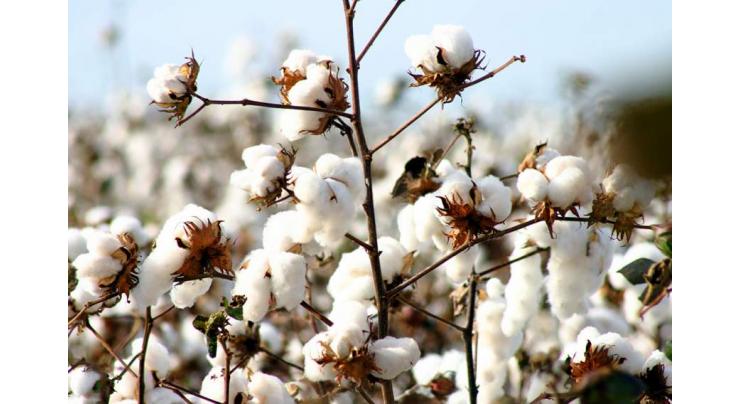
Cotton Cultivated Over 2.457 Mln Hectares, Sowing Decreases 1.3 %
Fahad Shabbir (@FahadShabbir) Published July 14, 2020 | 04:55 PM

Cotton crop sowing in the country during current season (2020-21) decreased by 1.3 percent as compared the sowing of the corresponding period of last year
ISLAMABAD, (UrduPoint / Pakistan Point News - 14th Jul, 2020 ) :Cotton crop sowing in the country during current season (2020-21) decreased by 1.3 percent as compared the sowing of the corresponding period of last year.
Cotton, which is among the major cash crop of the country and main sources of industrial raw material of largest export sector of national economy was on downwards trajectory due to various issues, said Cotton Commissioner in the Ministry of National food Security and Research Dr Khalid Abdullah.
Talking to APP here on Tuesday, he said that cotton crop had cultivated over 2.457 million hectares as against the set targets of 2.663 million hectares, which was less than 1.3 percent of targets fixed for this season.
He said that about 92 percent targets of cotton cultivation was achieved during current season, adding that crop was grown over 2.489 million hectares during same period of last year.
In Punjab, he said that area under cotton growing was decreased by 2.5 percent as crop had sown over 1.890 million hectares as compared the target of 2.03 million hectares.
However, he said that the cotton sowing in Sindh registered about 2.7 percent increase as it cultivated over 0.615 million hectares as against last year's 0.599 million hectares.
The Commissioner said that declining trend in cotton growing area was mainly attributed to increase in covered area under competing crops including sugarcane, maize and rice.
"Due to the low input cost and less investment in competing crops, besides decreasing pricing trends of cotton in international markets, the farmers preferred the cultivation of these crops and they shifted their land into other crops," he remarked.
The second main reason in decreasing area under cotton crop was late harvesting of wheat, he said adding that cotton was largely growing in wheat production areas and late wheat harvesting resulted in decline in cotton growing area.
The third and main reason, he said was the absence of cotton support price announcement by the government in the country, which discouraged the cotton growers.
Due to declining trend in cotton prices in international markets, the farmers were expecting government intervention to protect their interests, he said adding that absence of support price mechanism also discouraged the local farmers to cultivate the crop and encouraged them to shift no other crop with better returns.
Dr Abdullah further informed that during current Kharif season, sugarcane sowing witnessed about 16 percent increase as compared the same period of last year.
Meanwhile, the sowing of other competing crops like maize and rice had also witnessed significant growth, he said adding that country was already surplus in production of these crops.
In order to cope with the prevailing situation and encouraging the farmers to grow more cotton, he said government had evolved a scheme of incentives that would reduce the input cost of cotton, besides reducing the cost of doing business.
He said that government had announced subsidies on fertilizers and pesticides in its agricultural emergency program and farmers would be provided fertilizers and pesticides on controlled rates.
Besides, to ensure availability of cheaper agriculture credit, the government had also announced to pay 10 percent markup on agriculture loans for growers, adding that interest rate on agriculture lending was charged at the rate of 16 percent.
In order to control the pest attack on cotton like white fly and pink ballworm, he said government had also provided subsidy on the imports of PB Rope.
He said that government was also working to ensure 100 percent availability of high yielding, pest resistant seeds to enhance per-acre crop output.
Related Topics
Recent Stories

IHC adjourns PTI founder, Qureshi's appeal till Thursday

CDWP recommends 3 projects to ECNEC for approval

Tarar assures APNS to resolve issues of newspaper industry

Pakistan urged to capitalize on economic stability, for Tobacco Tax Reforms

N. Macedonia polls set to upend ties with EU neighbours

Croatia's ruling party reaches coalition deal with right wing

Bayern coach Tuchel makes three changes for Madrid showdown

Olympic flame arrives on French soil for Paris Games

Punjab Finance Minister announces expansion of Social Protection Authority's man ..

Kenya inks deal to end doctors' strike

Brazil flooding death toll reaches 100

Lebanon security source says five killed in Israeli strikes on south
More Stories From Business
-

CDWP recommends 3 projects to ECNEC for approval
6 hours ago -

Pakistan urged to capitalize on economic stability, for Tobacco Tax Reforms
6 hours ago -

Punjab Finance Minister announces expansion of Social Protection Authority's mandate
6 hours ago -

Delegation of dairy industry called on Finance Minister
7 hours ago -

Uzbek FM to deliberate matters of bilateral interest, trade augmentation
7 hours ago -

Pakistani fishing industry attracts Chinese investors: PCJCCI
8 hours ago
-

LCCI, PVTC to make joint efforts to bridge skill gap in industrial sector
8 hours ago -

French ambassador meets Finance minister
8 hours ago -

Wheat purchase record registered properly; growers being paid within 24 hours
8 hours ago -

Govt ensuring one stop solution to industrialists: Ikramullah Dharejo
8 hours ago -

Pak-Qatar Family Takaful achieves Rs156.3 turnover in 2023
8 hours ago -

First phase of Tajir Dost Scheme limited to only registration: FBR
9 hours ago

















